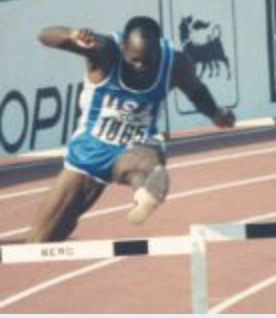Inventing Is Like The Olympics

I’ve never told anyone before. In 1984, at the Olympics in Los Angeles, in the LA Memorial Coliseum, with a crowd in the stands, I ran 400 meters around the track.
Yes, the official games were over and the crowd was leaving. But I ran on the same track on the same day (more or less) as Gold Medal winners Edwin Moses and Carl Lewis… with a pack of photographers who’d been taking pix at the finish line.
Working for Newsweek and ABC with photographer Ken Regan, my job at the running and hurdles events was to step on a remote trigger when the lead runner was approx 10 feet from the finish line. The trigger activated 3 cameras on tripods, prefocused on the finish line, equipped with wide angle through telephoto lenses. The telephoto was focused on the lane of the expected winner. Ever wonder how a photographer gets a picture of the winner at the finish line? That’s how. Back in the days of film, a roll of 35mm had 36 exposures. Trigger a motor drive on three cameras at 10 feet from the line and you’ll get the shot. Today you might step on the trigger at the start.
The expected winner almost always won. Carl Lewis, a sprinter, won 4 Gold Medals. Edwin Moses, a hurdler, won his only event, the 400 meter hurdles; he was the coolest dude by far.
Which brings me to inventing. In the world of inventing I’ve won three Gold Medals to date: for the Black and Decker Powershot® Staple Gun, the GatorGrip® universal socket and the PaperPro® desktop stapler. I didn’t win as the inventor. Think of the Oscars. I won as the producer, the guy who makes things happen.
Beyond my wins is a stadium full of losers. Losers that looked like winners to me at the time. No shame in losing. I feel great about having tried.
What is a Gold Medal in inventing? I say that a Gold Medal means over one million dollars into my own personal pocket.
At the Olympics I saw that the fastest guy in all of France looked like a total loser. The fastest guy in France didn’t win bronze. He was last. That’s my takeaway from the Olympics (other than the coolness of Edwin Moses). You may be the best in your world, but that’s not enough to win in THE WORLD.
Inventing is like that. You can have something phenomenal that people LOVE and it can still fail. It can have ALMOST EVERYTHING going for it, fantastic consumer demand and high profit margins and still fail.
The ALMOST is the key. Everyone in the supply chain must see higher than normal profit. AND THEN there’s timing. Timing is a great unknown. A fantastic product at the wrong time will not succeed.
What does that mean to inventors? If your current idea fails, try, try again. Give it an honest shot. If it doesn’t fly, put it on the shelf until another day and work on something else. I still love our first product, the SqueezeDriver®. That product won awards, made the cover of Brookstone, was sold by Sears catalog and on QVC; it was used by Johns Hopkins in surgery and licensed a few times. There were knockoffs. It never quite made it. We stopped making and selling it ourselves and no one else sells it today. A new and improved version sits on my shelf waiting for the right time.
That’s inventing.
Failure is part of the process and it isn’t necessarily permanent.
Keep on running. Sooner or later you may win gold.
share this article: facebook